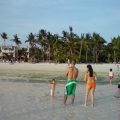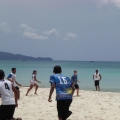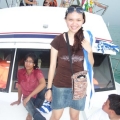- Information
- History
- Culture
- Weather
- When to go
- Good to know
- Visa and Passport
- Food
- Night Life
- Glossary
- Traveler Advice
- Destinations
- Trip Costs
Ad
The Glossary
Considered by many as the prime beach destination in the Philippines, Boracay beckons with its sugar-white sand and cerulean waters, characteristics which have made it one of the most prized possessions of the country. The renowned island paradise is a playground with all the recreational activities to quench the tourists' thirst for both adventure and amusement. A small speck of land off Panay's northern coast, Boracay was initially a closely-guarded secret among the local people. It was in the ‘70s that news of its pristine beaches broke out to the public and investors flocked to the island to establish resorts, restaurants, and nightclubs, transforming the seven sq. km. island from a chaste virgin to a celebrated pageant queen.
The island has four main beaches, and those who do not fancy crowded shores can go to Bulabog Beach. Windsurfers prefer this area of Boracay because of its stronger, wilder squalls. A peaceful trip can be found in the north of the island, in Puka Beach, from where puka shells can be collected. The most prominent beach, however, is the White Beach. Here, the four-kilometer shore teems with resorts, hotels, restaurants, and other establishments. The water body along the White Beach is often ripped by banana-boats and sailors in their vibrant paraws (an outrigger sailboat), while the shore is lined with colorful beach umbrellas, scarcely-clothed people tanning or walking around, and multitudes of vendors selling sunglasses, refreshments, and a hundred other items.
Boracay is famous not only for its pristine beaches, but also for the after-dark parties. Things get a lot more interesting once the magnificent sunset is over. Then the White Beach's nightclubs and parlors are vivified by performing musicians and fire dancers who can liven the night up until the wee hours.
Boracay photography
 sunset at boracay by lilmisstantrums
sunset at boracay by lilmisstantrums
 no title by SeaChild
no title by SeaChild
 no title by Enfant Terrible
no title by Enfant Terrible
 no title by chinxlexy
no title by chinxlexy
 A Kenneth Cobonpue chair by Enfant Terrible
A Kenneth Cobonpue chair by Enfant Terrible
 no title by Enfant Terrible
no title by Enfant Terrible
 no title by Enfant Terrible
no title by Enfant Terrible
Boracay Attractions:
Boracay Traveler Advice
From our blogsphere:
Hands On Volunteer Vacations By writeonthespot
Moving to Manila By TravelBug
In our Magazine
10 Things that Make Australia Rock
 As Australia celebrates its 222nd founding anniversary, it’s good to reflect on the 10 things that have put the country on the map and changed people’s lives for the better.
As Australia celebrates its 222nd founding anniversary, it’s good to reflect on the 10 things that have put the country on the map and changed people’s lives for the better.
Mt. Everest – A Challenge of a Lifetime
 Threatening with avalanches, extreme weather conditions and reduced oxygen level, Mt. Everest is definitely not for the faint of heart. Get to know how to climb and survive the highest point on Earth.
Threatening with avalanches, extreme weather conditions and reduced oxygen level, Mt. Everest is definitely not for the faint of heart. Get to know how to climb and survive the highest point on Earth.
Three Countries, One Day
 Thailand, Cambodia, Laos, Vietnam, Burma and China rely on the river Mekong for trade and tourism. Travelers who want to discover these countries can easily avail of cruises that last for as short as 24 hours.
Thailand, Cambodia, Laos, Vietnam, Burma and China rely on the river Mekong for trade and tourism. Travelers who want to discover these countries can easily avail of cruises that last for as short as 24 hours.






